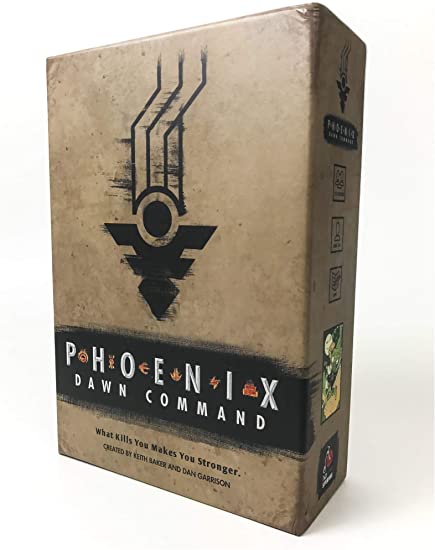I’m on a study project to improve my understanding of roleplaying games. To this end, I already have two reading projects, A Game Per Year and An Adventure Per Year. This is the third, with the goal of reading or playing 52 games made in the last few years. Originally I considered making this “A New RPG Per Week” and that’s where the number 52 comes from, even though a weekly schedule is probably not within my abilities.

In many ways, Phoenix Dawn Command is a gorgeous, clever game. It’s a fantasy roleplaying game with a war theme with a card-based system. It comes in a box with a hefty 400+ page book and a plethora of beautifully produced cards and tokens.
The player characters are Phoenixes, superhuman warriors defending the Empire against the Dread and other threats. The game’s cleverest idea is to have the Phoenixes reborn if they die, growing stronger with each death until they reach their seventh and final incarnation.
The design takes full advantage of this idea. The game features a fully detailed introductory campaign with many opportunities for heroic self-sacrifice. In this time, you want to make your character take terrible risks because the system rewards you for it.
War is a subject with specific challenges that manifest in Phoenix Dawn Command as well. There are many kinds of war stories but one line of demarcation is how to see the enemy. Are the soldiers fighting on the other side essentially human, the same as you, or are they inhuman monsters to be slaughtered without moral consequences?
Roleplaying games are addicted to righteous violence so there’s a strong demand for enemies that you can kill without having to feel bad about it. Phoenix Dawn Command goes down this route as well, making it’s enemy force mysterious, alien and inhuman. When the Phoenixes fight against the Dread, they’re fighting an existential threat. It’s not a war with two human sides that each have their own motivations and goals.
Another interesting subject is the Empire. Often in Anglo-American war fiction, the protagonists are tasked with defending the empire, whether a fictional one or the actual U.S. This presents the problem of how to make superior fighting forces into underdogs you can root for.
The Call of Duty series of videogames has a number of examples of this. In Ghosts, the oil-producing countries of South America form a Federation of the Americas and hijack U.S. orbital superweapons to shift the balance of power. This way, the player has a credible threat to fight while still having a full arsenal of technological gadgetry at his disposal.
The videogame Red Faction: Guerrilla is an interesting counter-example because it refuses the imperial perspective. Instead, the player character is fighting for freedom on Mars against an overwhelming colonialist enemy called the Earth Defence Force.
In Phoenix Dawn Command the problem of imperial underdogs has been solved by giving the elite Phoenixes a troubled history where they have been disbanded and are only now being reborn. At first common imperial citizens might not accept them as their saviors but if the player characters perform in a suitably heroic fashion popular acclaim will follow.
Another way to look at the effects of the imperial viewpoint is to consider the periphery of the fantasy world and how it’s depicted. Who among the conquered peoples are coded as sympathetic?
The standard imperial choice here is the same Phoenix Dawn Command also makes: Locals who side with the empire are the good guys. The world of the game has a southern forest area called the Grimwald. It has been colonized by the empire but never culturally integrated.
The Olvari are a Grimwald people who sided with the Empire when the Epire conquered the forest. Naturally in the campaign, they are the good guys. After all, we are imperial elite supersoldiers! That’s the perspective we look at the world from.
If you decided to take the point of view of Red Faction: Guerrilla, the Olvari would be collaborators and traitors and the Phoenixes themselves relentless but ultimately vanquishable enemies.
In terms of game design Phoenix Dawn Command feels fresh, interesting and smart. Its world design is intricate enough that you can do a critical reading, as I’ve done here. That’s nice when it sometimes feels like world design is a lost art in modern roleplaying games.